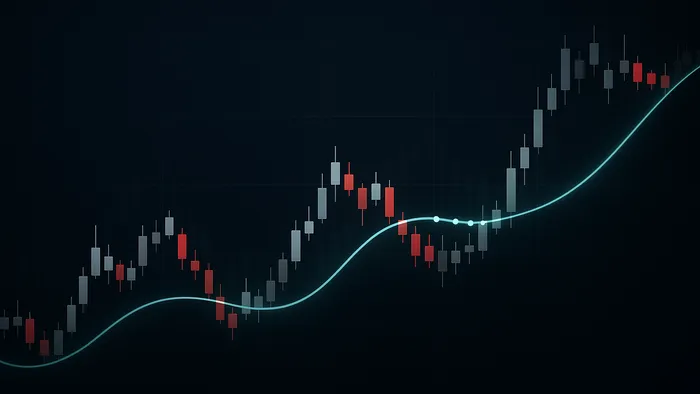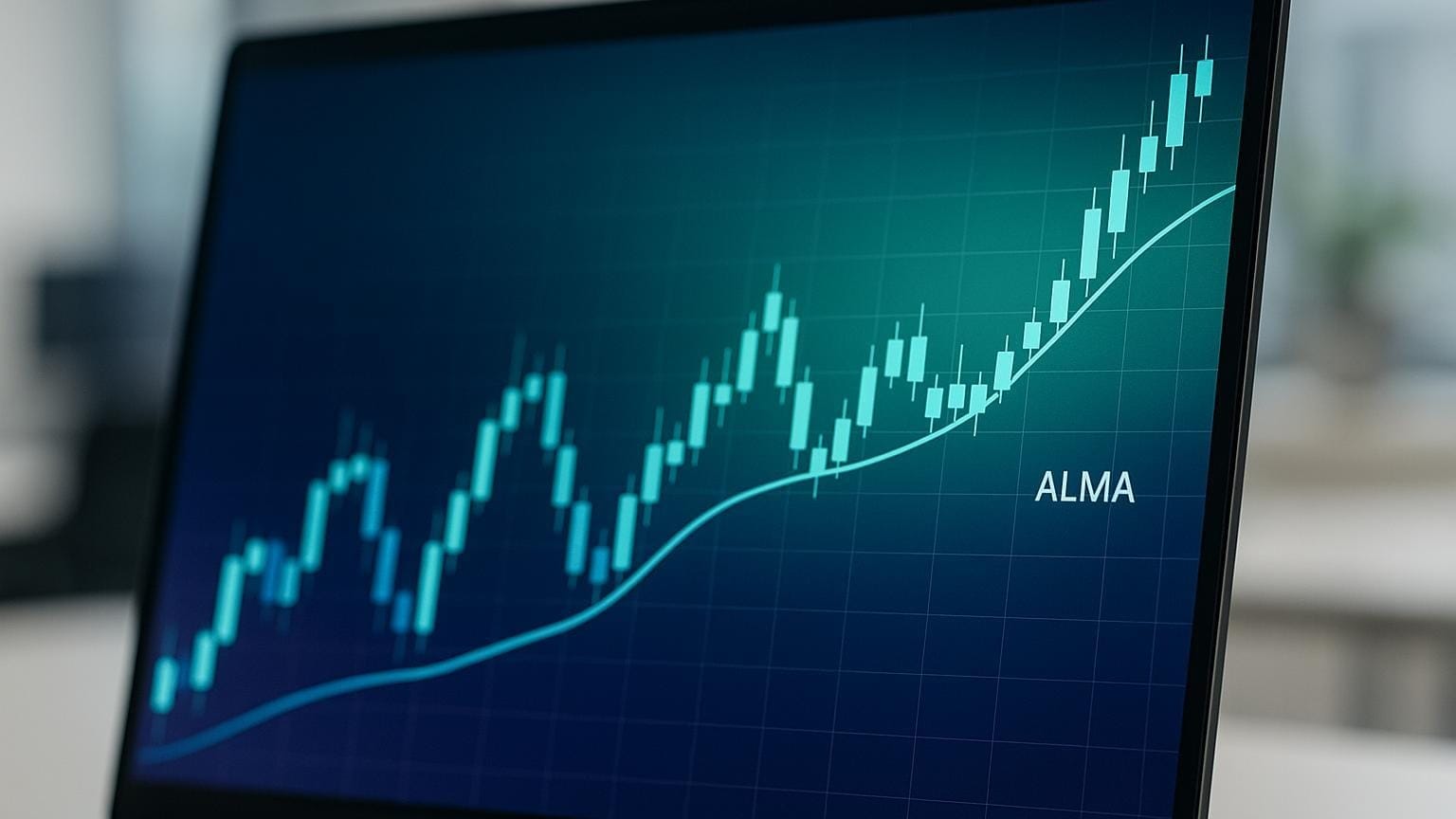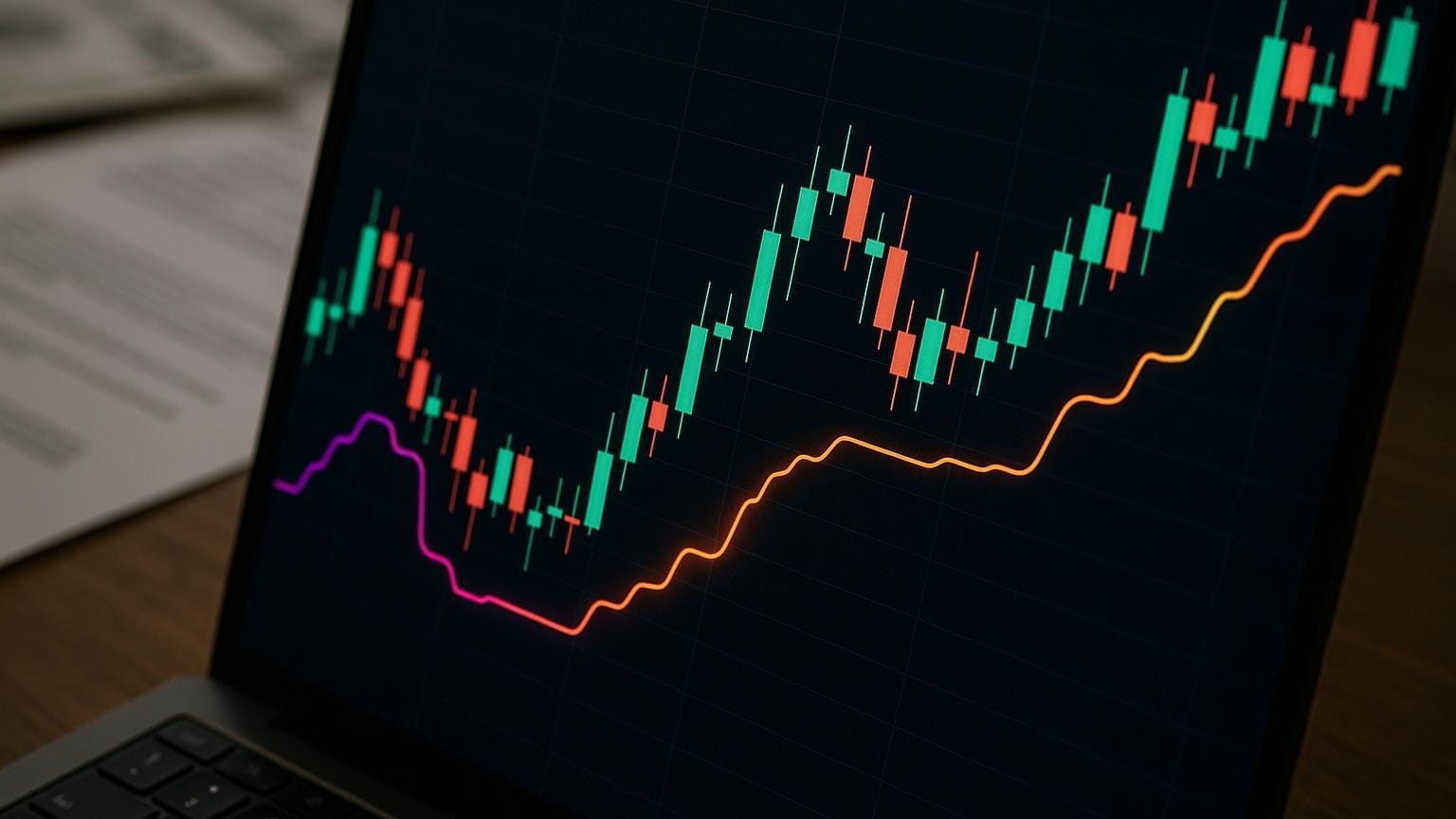Learn how the Weighted Moving Average (WMA) prioritizes recent price movements, enhancing trend detection and trading strategies.
The Weighted Moving Average (WMA) is a trading method that prioritizes recent price movements, offering faster trend detection compared to traditional moving averages. By assigning higher weights to newer data, WMA provides more responsive signals for traders. Here's what you need to know:
- Why WMA Matters: It reacts quickly to price shifts, making it ideal for identifying trends, key support/resistance levels, and trade signals.
- How It Works: The formula multiplies each price by its weight (recent prices get higher weights) and divides the total by the sum of weights.
- Example: For a 5-day WMA, recent prices like $154.10 have more influence than older ones like $150.25, resulting in a WMA of $152.26.
- Practical Use: Traders often pair WMA with other indicators (e.g., Relative Strength Index (RSI) or MACD) to confirm signals and reduce risks.
- Comparison: Unlike Simple Moving Average (SMA), which gives equal weight to all data points, WMA reacts faster but is more sensitive to short-term noise.
WMA is a flexible method for both short-term and long-term strategies, helping traders make quicker, informed decisions. You can also evaluate WMA variations with LuxAlgo’s backtesting features.
How to Calculate the Weighted Moving Average
The WMA Formula
The Weighted Moving Average (WMA) formula is simple: you multiply each price by its assigned weight, then divide the total by the sum of the weights. The trick is that the most recent price gets the highest weight, while older prices are assigned progressively smaller weights.
Here’s the formula:
WMA = (P₁ × W₁ + P₂ × W₂ + ... + Pₙ × Wₙ) ÷ (W₁ + W₂ + ... + Wₙ)
Where:
- P = Price for each period
- W = Weight assigned to each period
- n = Number of periods
In a typical WMA, the newest price gets the highest weight (n), the next gets n-1, and so on, with the oldest price receiving a weight of 1.
Step-by-Step Example
Let’s break it down with a real example. Suppose you want to calculate a 5-period WMA using Apple’s closing prices for five days:
- Day 1 (oldest): $150.25
- Day 2: $151.75
- Day 3: $149.50
- Day 4: $152.80
- Day 5 (most recent): $154.10
Step 1: Assign weights from 1 to 5, with 5 for the most recent day:
- $150.25 × 1 = $150.25
- $151.75 × 2 = $303.50
- $149.50 × 3 = $448.50
- $152.80 × 4 = $611.20
- $154.10 × 5 = $770.50
Step 2: Add up the weighted values:
$150.25 + $303.50 + $448.50 + $611.20 + $770.50 = $2,283.95
Step 3: Add the weights:
1 + 2 + 3 + 4 + 5 = 15
Step 4: Divide the weighted sum by the total weights:
$2,283.95 ÷ 15 = $152.26
So, the 5-period WMA is $152.26. This result emphasizes recent prices, making it more reflective of current market trends.
How Period Length and Weighting Affect Results
The length of the period and the weighting system directly influence how the WMA behaves. Shorter periods make the WMA more sensitive to price changes, which can be helpful for spotting quick trends but may also lead to false signals in choppy markets. On the other hand, longer periods smooth out the data, reducing noise but potentially delaying responses to sudden price shifts.
The linear weighting system (1, 2, 3, 4, 5…) ensures that recent prices carry more influence while still giving older prices a role in the calculation. For example, a 10-period WMA uses weights from 1 to 10, while a 3-period WMA uses weights 1 to 3, making it much more reactive to recent changes.
This flexibility allows traders to tailor the WMA to their specific needs. Day traders often opt for shorter periods to capture quick movements (see scalping), while swing traders might lean toward longer periods to avoid getting caught in intraday fluctuations (swing trading). The balance between responsiveness and stability makes the WMA a valuable method for various trading strategies.
Using WMA in Trading Strategies
Identifying Trends with WMA
The Weighted Moving Average (WMA) helps traders cut through market noise to better understand trend direction. By giving more importance to recent prices, the WMA reacts more quickly to market changes compared to traditional moving averages. This makes it especially useful for traders looking for timely signals.
When prices move above the WMA, it generally points to an uptrend; when prices fall below, it suggests a downtrend. The slope of the WMA adds another layer of confirmation for the trend's direction.
Analyzing multiple timeframes can make the WMA even more effective. For instance, traders might use a longer-period WMA, such as a 50-period, to identify the broader trend. At the same time, a shorter-period WMA, like a 10- or 15-period, can help fine-tune entry and exit points within that trend. This combination provides a solid foundation for identifying precise trading opportunities.
Creating Entry and Exit Signals
WMA crossovers are a popular way to generate entry and exit signals, especially when paired with price action for confirmation. A common approach involves using two WMAs of different lengths— a fast WMA (e.g., 10-period) and a slow WMA (e.g., 20-period). When the fast WMA crosses above the slow one, it may signal upward momentum. Conversely, when the fast WMA dips below the slow one, it often indicates downward pressure.
For added reliability, traders look for sustained price movements and increased volume to validate these crossover signals.
Exit strategies often involve trailing stops and monitoring momentum shifts. For example, as a trade moves in a favorable direction, stop-loss levels can be adjusted to trail just below the WMA for long positions or above it for short positions. This approach helps lock in profits while still allowing room for potential gains. Using additional tools alongside the WMA can further refine these strategies.
Using LuxAlgo with WMA
LuxAlgo provides tools on TradingView that elevate WMA-based analysis. The Signals & Overlays toolkit can complement WMA workflows with confirmations and dynamic overlays. The Smart Trail feature automatically adjusts support and resistance levels, making it easier to optimize exit points.
Additional features like Trend Tracer and Trend Catcher can work alongside WMA signals to detect trends early and confirm directional bias. The Neo Cloud overlay adds another layer by showing both trend direction and dynamic support and resistance zones.
LuxAlgo also offers visual enhancements, such as candle coloring, which reflects trend development in real time. A comprehensive dashboard provides actionable data, including metrics like Trend Strength, volatility, and volume analysis. With features like Screeners & Alerts, traders can monitor WMA conditions across multiple markets, ensuring they don’t miss high-probability setups while reducing the need for constant chart monitoring.
WMA vs Other Moving Averages
WMA vs SMA: Main Differences
The Weighted Moving Average (WMA) and Simple Moving Average (SMA) differ in how they treat price data. WMA places more emphasis on recent prices, assigning greater weight to the latest data points. For instance, in a 10-period WMA, the most recent price might carry a weight of 10, the previous day 9, and so on, with the oldest price weighted at 1. This structure allows WMA to react more quickly to recent price changes. On the other hand, SMA gives equal weight to all data points, creating a smoother trend line that often lags behind market movements.
| Feature | Simple Moving Average (SMA) | Weighted Moving Average (WMA) |
|---|---|---|
| Weighting Method | Equal weight for all data points | Higher weight for recent prices |
| Responsiveness | Slower to react to price changes | Faster reaction to recent movements |
| Smoothness | Smoother, less responsive signal | More volatile, quicker signals |
| Lag | Higher lag | Reduced lag due to recent emphasis |
| Best Use Case | Long-term trend identification | Short-term trend and momentum analysis |
Next, let’s see how WMA compares to the Exponential Moving Average (EMA), another approach that aims to reduce lag.
WMA vs EMA: Speed and Lag Comparison
While both WMA and EMA are designed to address the lag seen in SMA, they achieve this in distinct ways. WMA uses a straightforward weighting system that prioritizes recent prices, making it very responsive to short-term market changes.
EMA, however, applies an exponential formula that gradually reduces the influence of older prices. This method smooths out the indicator’s response, creating a less abrupt reaction to market shifts. The choice between WMA and EMA often comes down to the trader’s specific strategy and the type of market environment they are navigating.
WMA Pros and Cons
WMA’s strength lies in its ability to quickly reflect recent price movements, making it a valuable tool for identifying trends early and generating timely entry signals. Its design ensures that the most current market data has the greatest influence, aligning with the idea that recent price action is often the most relevant.
However, this sensitivity can be a double-edged sword. WMA’s rapid response to new data makes it susceptible to short-term market noise, which can lead to false signals. As a result, traders using WMA often need to incorporate confirmation techniques and maintain active risk management to avoid premature decisions.
Advanced WMA Tools and Backtesting with LuxAlgo
Testing WMA Strategies with AI Backtesting Assistant
Take WMA strategies to the next level with LuxAlgo’s AI Backtesting Assistant, which lets you test approaches across assets and timeframes. It provides a risk-free environment to experiment with various WMA configurations, helping identify effective periods and weights for your strategy.
By integrating insights with LuxAlgo’s toolkits, the platform enables you to evaluate WMA signals alongside other features. Its optimization engine analyzes multiple WMA parameters, offering tailored, data-driven recommendations that align with your trading style—saving significant time in the backtesting process.
Screeners and Real-Time WMA Analysis
LuxAlgo’s screeners enhance WMA analysis by identifying high-probability setups across the market. The Signals & Overlays screener filters assets based on WMA crossovers, trend confirmations, and momentum shifts, sending alerts when your specific criteria are met.
Each of LuxAlgo’s primary toolkits—Price Action Concepts, Signals & Overlays, and Oscillator Matrix—comes equipped with its own screener that integrates WMA analysis. This eliminates the need to manually sift through charts, making it easier to act on actionable insights. The Custom Alert Creator adds another layer of precision by allowing you to design alerts based on WMA slope changes or price-to-WMA distances. Together, these features enhance trend validation and improve timing for entries and exits.
Learning from the LuxAlgo Community
The LuxAlgo community is a valuable resource for refining advanced WMA strategies. Members actively share their experiences, offering practical advice that goes beyond theoretical concepts.
"I have even made a good friend in the channel with who I discuss strategies and ideas. Finally found the tools that I need and place where I can possibly get to the next level." – Raul [1]
Within this collaborative space, users exchange insights on the best WMA configurations for different asset classes and market conditions. Creators and admins also play an active role, answering technical questions and providing guidance. This collective effort helps traders fine-tune backtesting results, adjust parameters, and build more advanced trading systems.
Why WMA Matters for Data-Driven Trading
Main Benefits of WMA
The Weighted Moving Average (WMA) is a standout method for traders, offering precise and responsive signals by giving more weight to recent price data. This emphasis on current prices makes it a go-to choice for detecting trends early and minimizing lag. In fast-moving markets, where split-second decisions can make or break a trade, this responsiveness is a game-changer.
WMA works across various timeframes and market conditions, making it suitable for traders with different strategies. Whether you're focused on short-term scalping using 5-minute charts or prefer swing trading on daily timeframes, WMA delivers clear entry and exit signals. Its sensitivity ensures you're tuned into the price movements that matter most.
Beyond trend detection, WMA is invaluable for setting precise stop-loss and take-profit levels—key elements of effective risk management. Because it quickly adapts to price changes, WMA helps traders avoid being prematurely stopped out by short-term market noise while still protecting against genuine trend reversals.
These features combine to make WMA not just an indicator but an actionable approach for traders aiming to refine and enhance their strategies.
Getting Started with WMA
To harness the benefits of WMA, start by integrating it into your trading routine using LuxAlgo’s intuitive toolkits on TradingView. Begin with trend identification by applying WMA to your preferred trading timeframe. Compare its responsiveness to other moving averages you may already use, and note how it reacts to price shifts.
LuxAlgo’s automated features and screeners simplify WMA analysis. Instead of manually scanning endless charts for WMA setups, use a screener to identify specific conditions like crossovers, slope changes, or deviations between price and the WMA. This saves time and ensures you focus on the most relevant opportunities.
Tap into the LuxAlgo community for practical advice and insights from traders who’ve successfully applied WMA strategies across various markets and asset classes. Their shared experiences can help you sidestep common mistakes and uncover advanced techniques you might not have thought of on your own.
Before going live, test your WMA setup through backtesting or paper trading. Use LuxAlgo’s capabilities to fine-tune your settings, validate your strategy, and build confidence in your approach. This step-by-step process ensures you're prepared to make informed decisions when trading with real capital.
Weighted Moving Average Explained — Calculation, Formula, and Tips for Traders
FAQs
How does the Weighted Moving Average (WMA) differ from the Exponential Moving Average (EMA) in terms of responsiveness and lag?
The Weighted Moving Average (WMA) places greater emphasis on recent prices, which helps minimize lag when compared to simpler moving averages. This makes it a solid choice for traders who want to factor in the most current price movements without completely discarding older data.
On the other hand, the Exponential Moving Average (EMA) is typically more sensitive to price changes. By applying an exponential weighting to recent data, the EMA adjusts more quickly to shifts in the market, making it especially useful for short-term trading strategies.
While both methods focus on recent price activity, the EMA's faster reaction to sudden price changes gives it an edge for quick market analysis. Meanwhile, the WMA delivers a smoother trendline, appealing to those who prefer a balance between fast adjustments and a steadier view of market trends.
How can I effectively use the Weighted Moving Average (WMA) with indicators like RSI and MACD to improve my trading decisions?
To make the most of the Weighted Moving Average (WMA) alongside indicators like RSI and MACD, start by using the WMA to gauge the overall market trend. If the WMA indicates an upward trend, prioritize looking for buying opportunities. Conversely, a downward trend suggests focusing on potential selling opportunities.
Once you've identified the trend, combine the WMA with RSI to refine the entry and exit points. RSI helps confirm overbought or oversold conditions that align with the trend direction shown by the WMA. Lastly, use MACD to detect momentum changes— for example, if MACD shows a bullish crossover during an uptrend confirmed by the WMA, it could signal a stronger entry point.
How do LuxAlgo’s tools enhance the effectiveness of the Weighted Moving Average (WMA) for traders, and which features are the most useful?
LuxAlgo enhances WMA analysis with customizable indicators that help traders analyze trends and make decisions with greater precision. With features like real-time confirmations, candle coloring, and adjustable WMA settings, you can focus on recent price movements to pinpoint trends and potential reversals more effectively.
These capabilities also help refine strategies, making it simpler to respond to shifting market conditions and boost trading performance. By using these features, traders can uncover actionable insights and approach decisions with increased confidence backed by data.
References
LuxAlgo Resources
- Understanding Moving Averages and How Traders Use Them
- Support & Resistance Levels with Breaks
- Battle Signals
- Moving Averages Proximity Oscillator (SMA context)
- Backtester (Signals & Overlays)
- Fetching Strategies (AI Backtesting Docs)
- Multi-Timeframe Market Formation
- Backtesting System — PAC Exits
- Price Action Concepts
- Market Structure Trailing Stop
- Liquidation Levels
- Candle Coloring (S&O Docs)
- AI Backtesting Assistant
- LuxAlgo Homepage
- TPSL (OSC Backtesting Docs)








